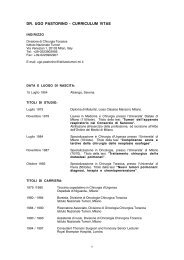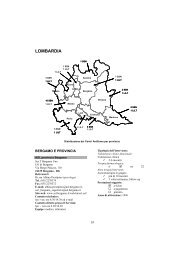Screening for lung cancer: a review
Screening for lung cancer: a review
Screening for lung cancer: a review
Create successful ePaper yourself
Turn your PDF publications into a flip-book with our unique Google optimized e-Paper software.
<strong>Screening</strong> <strong>for</strong> <strong>lung</strong> <strong>cancer</strong>: a <strong>review</strong><br />
Renee Manser<br />
Purpose of <strong>review</strong><br />
After the disappointing results of <strong>lung</strong> <strong>cancer</strong> screening trials<br />
conducted in the 1960s to the 1980s, a renewed interest in<br />
<strong>lung</strong> <strong>cancer</strong> screening emerged in the 1990s with the<br />
development of new technologies such as low-dose spiral CT.<br />
The literature regarding screening with biomarkers and CT<br />
continues to expand rapidly.<br />
Recent findings<br />
Although the specificity of CT screening is relatively poor, the<br />
sensitivity <strong>for</strong> the detection of early-stage <strong>cancer</strong>s, particularly<br />
adenocarcinoma, is considerably superior to that of chest<br />
radiography used in older screening trials. The results of<br />
uncontrolled cohort studies of CT screening are promising, but<br />
such studies are susceptible to screening biases such as<br />
overdiagnosis.<br />
Summary<br />
There is insufficient evidence to support widespread screening<br />
in current practice. However, randomized controlled trials are<br />
now being conducted to determine whether improved<br />
detection by CT will translate into reduced <strong>lung</strong> <strong>cancer</strong><br />
mortality. Alternative approaches to secondary prevention such<br />
as screening with biomarkers, autofluorescence<br />
bronchoscopy, and chemoprevention hold great promise <strong>for</strong><br />
the future but await further development and evaluation in<br />
prospective trials.<br />
Keywords<br />
mass screening, computed tomography, chest radiography,<br />
sputum cytology, <strong>lung</strong> neoplasms<br />
Curr Opin Pulm Med 10:266–271. © 2004 Lippincott Williams & Wilkins.<br />
Clinical Epidemiology and Health Service Evaluation Unit, Royal Melbourne<br />
Hospital, Victoria, Australia, and the Department of Respiratory Medicine, St.<br />
Vincent’s Hospital, Victoria, Australia<br />
Correspondence to Renee Manser, Clinical Epidemiology and Health Service<br />
Evaluation Unit, Ground Floor, Charles Connibere Building, Royal Melbourne<br />
Hospital, Grattan Street, Parkville 3050, Victoria, Australia<br />
Tel: +61 3 9342 8772; fax: +61 3 9342 7060; e-mail: ManserRL@mh.org.au<br />
Supported by a National Health and Medical Research Council postgraduate<br />
scholarship (scholarship number 201713).<br />
Current Opinion in Pulmonary Medicine 2004, 10:266–271<br />
Abbreviation<br />
RCT randomized controlled trial<br />
© 2004 Lippincott Williams & Wilkins<br />
1070-5287<br />
266<br />
Introduction<br />
Lung <strong>cancer</strong> remains a major public health problem in<br />
most industrialized countries [1,2]. Most <strong>lung</strong> <strong>cancer</strong>s are<br />
attributable to cigarette smoking, and primary prevention<br />
is a continuing priority. Increasingly, <strong>lung</strong> <strong>cancer</strong> is<br />
now occurring in ex-smokers [3]. Additional preventive<br />
strategies are needed to reduce the mortality from this<br />
epidemic. Whereas early <strong>lung</strong> <strong>cancer</strong> screening trials<br />
have yielded disappointing results, more sensitive<br />
screening techniques have been developed, including<br />
biomarkers and low-dose CT. Research progress has<br />
been most rapid with radiological approaches and randomized<br />
controlled trials (RCTs) of CT screening are<br />
currently being conducted. In the interim. debate<br />
continues over the potential cost effectiveness of CT<br />
screening and its appropriate use in contemporary clinical<br />
practice.<br />
<strong>Screening</strong> with plain chest radiography<br />
The efficacy of chest radiography screening <strong>for</strong> <strong>lung</strong> <strong>cancer</strong><br />
continues to be debated [4•,5•,6••]. A systematic<br />
<strong>review</strong> of controlled trials of <strong>lung</strong> <strong>cancer</strong> screening <strong>review</strong>ed<br />
the evidence from seven trials [6••,7]. In all<br />
studies, the control group received some type of screening.<br />
Five studies effectively compared more frequent<br />
chest radiography screening with less frequent chest radiography<br />
screening [8–12]. In the meta-analysis, more<br />
frequent chest radiograph screening was associated with<br />
an 11% relative increase in mortality from <strong>lung</strong> <strong>cancer</strong><br />
(relative risk 1.11, 95% confidence interval 1.00–1.23)<br />
[6••,8,10–12]. Although the possibility of harm from<br />
screening exists, the finding of increased mortality in the<br />
frequently screened group could be due to inadequate<br />
randomization resulting in population heterogeneity between<br />
the control and intervention groups. However, the<br />
trend to increased mortality was seen in all studies <strong>review</strong>ed.<br />
Another alternative explanation is that <strong>lung</strong> <strong>cancer</strong><br />
deaths could have been undetected or unreported in<br />
the control group and that some deaths in the intervention<br />
group due to comorbid disease were misclassified as<br />
death due to <strong>lung</strong> <strong>cancer</strong> [13,14]. None of the trials reported<br />
have adequately assessed the efficacy of annual<br />
chest radiograph screening compared with no screening,<br />
and this issue is currently being evaluated in the Prostate,<br />
Lung, Colorectal, and Ovarian Cancer <strong>Screening</strong><br />
Trial [15]. However, this trial has already attracted criticism<br />
<strong>for</strong> a failure to enroll high-risk groups [16].
Low-dose spiral computed<br />
tomography screening<br />
Bepler et al. [17••] have recently <strong>review</strong>ed several cohort<br />
studies (without historical controls) [18–24]. The <strong>review</strong>ers<br />
reported that CT screening resulted in a threefold<br />
higher detection rate and a fivefold increase in the rate of<br />
resectable <strong>cancer</strong>s relative to chest radiograph screening.<br />
However, CT screening appears to selectively detect adenocarcinomas,<br />
with an approximately twofold to threefold<br />
oversampling of this histologic subtype [17••]. This<br />
may reflect length-biased sampling, overdiagnosis bias,<br />
selection bias, or inadequate detection of endobronchial<br />
squamous cell carcinomas [25,26••].<br />
The specificity of CT screening is poor, ranging between<br />
89% and 49% in high-risk populations at baseline screening<br />
and being lowest with multislice CT [21,26••,27].<br />
There is no standard approach to the evaluation of most<br />
nodules detected by CT, most of which are small (5<br />
mm). Serial imaging can be used to limit the number of<br />
biopsies <strong>for</strong> benign disease, but benign nodules may<br />
show radiologic evidence of nodule growth, whereas<br />
some <strong>cancer</strong>s have long doubling times [26••,27,28]. In<br />
most studies reported, smaller indeterminate noncalcified<br />
nodules were monitored with repeat CT at 3 or 6<br />
months. Emerging evidence suggests that lesions less<br />
than 5 mm could be reimaged at 12 months to reduce the<br />
number of diagnostic evaluations [29•]. In one study,<br />
follow-up of nodules 5 mm or less was deferred until 12<br />
months [30••]. Six <strong>cancer</strong>s diagnosed at repeat screening<br />
were identified at baseline CT, but all were stage Iat<br />
diagnosis [30••]. In the same study, positron emission<br />
tomography was also used in the diagnostic algorithm,<br />
but this approach did not reduce the rate of benign biopsy<br />
results compared with other studies [30••].<br />
Current methods of evaluation and management of small<br />
nodules detected by CT require validation in long-term<br />
studies. Issues such as the frequency and duration of<br />
follow-up are yet to be resolved. Previous reports based<br />
on chest radiography show that some <strong>lung</strong> <strong>cancer</strong>s can<br />
appear stable <strong>for</strong> many years be<strong>for</strong>e growth is detected at<br />
serial follow-up [31,32]. Furthermore, slow growth of a<br />
primary tumor does not preclude metastatic spread [33].<br />
Growth can be more accurately detected by CT than by<br />
chest radiography [28]. However, even with serial CT<br />
examinations, it is likely that follow-up of more than 2<br />
years will be necessary <strong>for</strong> some nodules [34•]. The medicolegal<br />
implications of delayed diagnosis in this setting<br />
are untested but could be similar to the experience reported<br />
<strong>for</strong> breast <strong>cancer</strong> [35]. In the future, biomarkers,<br />
in addition to growth patterns, could be used to help<br />
distinguish between benign, premalignant, and malignant<br />
lesions, but the feasibility and validity of such an<br />
approach requires further evaluation [36•].<br />
Although some experts have questioned the role of<br />
RCTs in the setting of screening evaluation, they are<br />
<strong>Screening</strong> <strong>for</strong> <strong>lung</strong> <strong>cancer</strong> Manser 267<br />
generally considered to be the gold standard [37,38].<br />
Several RCTs of CT screening are being planned or are<br />
in progress [39•]. The National Lung <strong>Screening</strong> Trial is<br />
a National Cancer Institute—sponsored RCT comparing<br />
annual chest radiography with annual spiral low-dose CT<br />
<strong>for</strong> 3 years. This trial has enrolled nearly 50,000 exsmokers<br />
and current heavy smokers across multiple centers<br />
in the United States. Enrollment closed in February<br />
2004, and participants will be followed up until 2009<br />
[39a]. A further RCT will be conducted in the Netherlands<br />
and Leuven (Belgium) [40].<br />
Cost-effectiveness of computed<br />
tomography screening <strong>for</strong> <strong>lung</strong> <strong>cancer</strong><br />
In a cost-effectiveness analysis based on the results of<br />
the Early Lung Cancer Action Project, an incremental<br />
cost-effectiveness ratio of $2500 per life year saved <strong>for</strong> a<br />
single baseline low-dose CT scan in high-risk individuals<br />
was reported [41•]. These results differ markedly from<br />
those of another cost-effectiveness analysis in which relevant<br />
probabilities were based on the weighted average<br />
of several CT studies and quality-adjusted life years<br />
were assessed in addition to life years saved [42••]. In<br />
this model, current smokers in a hypothetical cohort<br />
were considered who were offered annual low-dose CT<br />
screening compared with a cohort not offered screening.<br />
The model predicted, over a 20-year period, a 13% reduction<br />
in <strong>lung</strong> <strong>cancer</strong>–specific mortality, assuming a<br />
50% stage shift. The incremental cost effectiveness ratio<br />
per quality-adjusted life year was $116,300 [42••]. This<br />
analysis was criticized because of the large number of<br />
variables included, some of which were estimated from<br />
limited data [43]. The disparity between the results of<br />
these analyses and others is a reflection of the different<br />
assumptions used in the models and particularly the<br />
level of uncertainty in the estimates of screening efficacy.<br />
Future analyses based on the results of RCTs are<br />
likely to yield more reliable results. Identification of very<br />
high-risk groups is likely to be the most cost-effective<br />
screening strategy [42••]. This could be achieved by the<br />
use of a prediction model or by identifying high-risk<br />
subgroups such as those with chronic obstructive airway<br />
disease [44•,45,46]. However, comorbidity may limit the<br />
potential health gains of screening these populations<br />
[47].<br />
Overdiagnosis: the debate continues<br />
Overdiagnosis may occur if a screening program detects<br />
a case of <strong>cancer</strong> that would not, even in the absence of<br />
screening and early intervention, have led to death in<br />
that individual’s lifetime. Henschke et al. [48•] consider<br />
overdiagnosed lesions to be those that, although morphologically<br />
malignant, have an indolent natural course and<br />
would not progress to cause death, regardless of competing<br />
causes of mortality. Although it is probable that, according<br />
to this definition, overdiagnosis is uncommon,<br />
slowly growing adenocarcinomas with long doubling
268 Neoplasms of the <strong>lung</strong><br />
times are well documented [49–51]. The detection of<br />
such indolent tumors may be more common in low-risk<br />
populations. For example, the detection rate of <strong>lung</strong> <strong>cancer</strong><br />
by CT screening is much higher than expected from<br />
mortality data among nonsmoking women [52•]. Other<br />
experts argue that in any screening program a proportion<br />
of screen-detected cases will be “pseudodisease” simply<br />
because of competing mortality [14]. The findings of the<br />
Mayo Lung Project are consistent with overdiagnosis<br />
bias [8,53]. However, in a recent retrospective <strong>review</strong> of<br />
tumor doubling times of incident <strong>cancer</strong>s diagnosed in<br />
the Mayo Lung Project and the Memorial Sloan-<br />
Kettering studies, it was reported that only 5% of stage I<br />
<strong>cancer</strong>s had doubling times of more than 400 days [54•].<br />
However, indolent tumors are most likely to be detected<br />
by prevalence screening, and this finding does not exclude<br />
the possibility of overdiagnosis resulting from competing<br />
mortality.<br />
As with any new screening test, it is probable that CT<br />
will detect lesions that have not previously been observed<br />
and have an unknown natural history. Observational<br />
studies in selected populations with unresected<br />
stage I<strong>cancer</strong>, detected by chest radiography, have reported<br />
poor 5-year survival rates of between 10% and<br />
25% [55–57]. Most recently, a high case-fatality rate was<br />
reported <strong>for</strong> unresected stage IA <strong>lung</strong> <strong>cancer</strong>s documented<br />
in the Surveillance, Epidemiology, and End Results<br />
registry [48•]. However, observational studies are<br />
subject to selection bias. For example, in one report<br />
squamous cell carcinoma was overrepresented [55]. In<br />
addition, bias may arise in assigning cause of death [58].<br />
Furthermore, comorbid conditions that contraindicate<br />
surgery could also impair host defenses against the tumor<br />
and increase <strong>lung</strong> <strong>cancer</strong> mortality [58]. Because CT can<br />
detect smaller lesions than chest radiography, the potential<br />
<strong>for</strong> overdiagnosis is greater. In a <strong>review</strong> of coronial<br />
autopsies, approximately 1 in 300 decedents going to<br />
autopsy had <strong>lung</strong> <strong>cancer</strong> detected that was undetected<br />
during life and did not contribute to death [59]. However,<br />
although incidental <strong>cancer</strong>s were uncommon, the<br />
median tumor size of incidental lesions was 3 cm (range<br />
1–10 cm), and it is likely that routine autopsies may not<br />
detect many of the smaller <strong>cancer</strong>s currently detectable<br />
by CT [59,60].<br />
The natural history of <strong>lung</strong> <strong>cancer</strong>:<br />
implications <strong>for</strong> early detection<br />
and treatment<br />
The tendency <strong>for</strong> CT screening to detect predominantly<br />
adenocarcinomas may be viewed favorably, given that<br />
this is now the predominant histologic type of <strong>lung</strong> <strong>cancer</strong><br />
in many industrialized countries [61]. However, it is<br />
possible that the benefits of early detection and treatment<br />
could differ between different histologic groups.<br />
Squamous cell carcinomas tend to be centrally located<br />
and grow more rapidly than adenocarcinomas but are less<br />
likely to metastasize to distant sites after surgery <strong>for</strong> localized<br />
disease [62]. Furthermore, lymph node micrometastases<br />
are more common in small peripheral adenocarcinomas,<br />
compared with small peripheral squamous cell<br />
carcinomas, being demonstrable in 36% of adenocarcinomas<br />
1 cm or less in size, but absent or uncommon in<br />
squamous cell carcinomas of 2 cm or less [63]. On the<br />
basis of tumor doubling times, it has been estimated that<br />
an adenocarcinoma takes an average of 13.2 years to<br />
reach 1 cm and a further 2.2 years to reach 3 cm [64]. It<br />
is not surprising that smaller tumors might demonstrate<br />
prolonged disease-free survival when measured from the<br />
point of diagnosis, because it is likely that many will have<br />
been detected at an earlier point in their development<br />
[65•]. The question remains whether the natural history<br />
will be altered by early detection and intervention, particularly<br />
given the long duration of adenocarcinoma prior<br />
to detection with current screening methods.<br />
The benefit of screening is dependent on having effective<br />
therapy <strong>for</strong> early-stage disease. However, there have<br />
been no reported RCTs of surgery or radiotherapy <strong>for</strong><br />
stage Ior stage IInon–small cell <strong>lung</strong> <strong>cancer</strong>s that have<br />
included an untreated control group [58,66]. In one early<br />
study, pneumonectomy or lobectomy improved survival<br />
at 4 years in patients with squamous cell carcinoma compared<br />
with radiotherapy [67]. Whereas observational data<br />
support the role of surgery <strong>for</strong> early-stage non–small cell<br />
<strong>lung</strong> <strong>cancer</strong>, the magnitude of any benefit and the types<br />
of patients who benefit most is unclear. Some experts<br />
have postulated that non–small cell <strong>lung</strong> <strong>cancer</strong> is a biologically<br />
variable disease in which anatomic staging identifies<br />
more indolent tumors that are likely to have a more<br />
favorable clinical course regardless of the intervention<br />
[58,64]. This hypothesis warrants further consideration<br />
in relation to adenocarcinoma, which is particularly heterogeneous,<br />
with a wide range of doubling times reported<br />
[51,68]. In one study of slow-growing tumors, survival<br />
in individuals with adenocarcinoma correlated well<br />
with tumor doubling time, even in those with resected<br />
tumors [50]. Lung <strong>cancer</strong> studies of gene expression arrays<br />
have identified different subclasses of adenocarcinoma<br />
with particular patterns of gene expression that<br />
correlate with survival [69,70]. What remains unclear is<br />
whether subclasses with different gene expression patterns<br />
have arisen from different precursor cells or whether<br />
the subclass with a more favorable gene expression<br />
pattern is simply at an intermediate point in the development<br />
to the invasive phenotype [70].<br />
Alternative approaches<br />
Although standard sputum cytology lacks sensitivity,<br />
new methods of sputum analysis have now been developed,<br />
such as automated quantitative image cytometry,<br />
immunohistochemical analysis, and molecular approaches<br />
[26••,71•,72]. Blood biomarkers are also being<br />
investigated [73•]. These approaches require validation
in large prospective trials [71•,72]. In a recent study of<br />
automated quantitative image cytometry in conjunction<br />
with low-dose CT screening in high-risk individuals, automated<br />
quantitative image cytometry was shown to enhance<br />
the detection of <strong>lung</strong> <strong>cancer</strong> by CT, but specificity<br />
was poor, with 75% of individuals having sputum atypia<br />
detected by automated quantitative image cytometry<br />
[26••]. Only 1 <strong>cancer</strong> was detected by CT alone’ however,<br />
CT failed to detect 4 of 14 <strong>lung</strong> <strong>cancer</strong>s. The 4<br />
missed lesions were all squamous cell carcinomas (3<br />
stage 0 and 1 stage IA) identified by autofluorescence<br />
bronchoscopy [26••]. Although this approach has the potential<br />
to reduce the number of initial CT scans by 25%,<br />
nearly three quarters of individuals screened would require<br />
autofluorescence bronchoscopy [26]. However, in<br />
another study, baseline autofluorescence bronchoscopy<br />
findings were predictive of subsequent squamous cell<br />
carcinoma in high-risk patients and there<strong>for</strong>e may identify<br />
a subgroup requiring closer follow-up [74•].<br />
Molecular approaches are likely to be the most effective<br />
early detection method because they can lead to the<br />
detection of preinvasive changes and there<strong>for</strong>e provide<br />
the opportunity <strong>for</strong> intervention at a much earlier point<br />
in the development of <strong>cancer</strong>. Coupled with noninvasive<br />
chemoprevention, molecular approaches could be more<br />
widely applicable [72]. In the future, noninvasive and<br />
well-tolerated chemoprevention could have a role in<br />
both primary and secondary prevention [75••]. Molecular<br />
targeted agents are currently being evaluated in clinical<br />
trials to assess their ability to prevent the appearance<br />
and progression of premalignant lesions in <strong>for</strong>mer or current<br />
smokers with a history of smoking-related <strong>cancer</strong><br />
[76•].<br />
Conclusion<br />
Low dose spiral CT screening is a sensitive screening<br />
technique <strong>for</strong> early-stage <strong>lung</strong> <strong>cancer</strong>, particularly adenocarcinoma.<br />
However there is insufficient evidence to<br />
support screening in contemporary practice. In the future,<br />
the results of RCTs will better in<strong>for</strong>m us about<br />
whether the early detection and treatment of <strong>cancer</strong>s<br />
detected by CT leads to a reduction in mortality and if<br />
the potential benefits of screening outweigh the harms<br />
associated with false positive diagnoses or overdiagnosis.<br />
If CT screening has only a small impact on <strong>lung</strong> <strong>cancer</strong><br />
mortality then cost effectiveness will most likely be unfavorable<br />
in the context of current diagnostic and therapeutic<br />
approaches. Alternative approaches to secondary<br />
prevention such as screening with biomarkers, autofluorescence<br />
bronchoscopy and chemoprevention await further<br />
development and evaluation in prospective trials.<br />
Acknowledgments<br />
The author thanks Dr. David Hart <strong>for</strong> <strong>review</strong>ing the manuscript.<br />
<strong>Screening</strong> <strong>for</strong> <strong>lung</strong> <strong>cancer</strong> Manser 269<br />
References and recommended reading<br />
Papers of particular interest, published within the annual period of <strong>review</strong>,<br />
have been highlighted as:<br />
of special interest<br />
of outstanding interest<br />
1 Lopez A: The <strong>lung</strong> <strong>cancer</strong> epidemic in developed countries. In: Adult mortality<br />
in developed countries: from description to explanation. Edited by Lopez A,<br />
Caselli G, Valkonen T. Ox<strong>for</strong>d; 1995: 111–134.<br />
2 Wingo P, Cardinez CJ, Landis SH, et al.: Long-term trends in <strong>cancer</strong> mortality<br />
in the United States, 1930–1998. Cancer 2003, 97(Suppl):3133–3275.<br />
3 Burns D: Primary prevention, smoking, and smoking cessation: implications<br />
<strong>for</strong> future trends in <strong>lung</strong> <strong>cancer</strong> prevention. Cancer 2000, 89(Suppl):2506–<br />
2509.<br />
4 Sagawa M, Nakayama T, Tsukada H, et al.: The efficacy of <strong>lung</strong> <strong>cancer</strong><br />
screening conducted in 1990s: four case-control studies in Japan. Lung Cancer<br />
2003, 41:29–36.<br />
This report is a meta-analysis of recent case-control trials of <strong>lung</strong> <strong>cancer</strong> screening<br />
in Japan.<br />
5 Marcus P: Conflicting evidence in <strong>lung</strong> <strong>cancer</strong> screening: randomized controlled<br />
trials versus case-control studies. Lung Cancer 2003, 41:37–39.<br />
This editorial examines the possible reasons <strong>for</strong> discrepancies between the results<br />
of recent case-control studies and previous controlled trials of <strong>lung</strong> <strong>cancer</strong> screening<br />
and discusses some of the limitations of case-control studies.<br />
6 Manser R, Irving LB, Byrnes G, et al.: <strong>Screening</strong> <strong>for</strong> <strong>lung</strong> <strong>cancer</strong>: a systematic<br />
<strong>review</strong> and meta-analysis of controlled trials. Thorax 2003, 58:784–789.<br />
Comprehensive overview of controlled trials of <strong>lung</strong> <strong>cancer</strong> screening that have<br />
been reported to date.<br />
7 Manser R, Irving LB, Byrnes G, et al.: <strong>Screening</strong> <strong>for</strong> <strong>lung</strong> <strong>cancer</strong> (Cochrane<br />
Review). In: The Cochrane Library, Issue 3, 2001. Ox<strong>for</strong>d: Update Software;<br />
2001.<br />
8 Fontana RS, Sanderson DR, Woolner LB, et al.: <strong>Screening</strong> <strong>for</strong> <strong>lung</strong> <strong>cancer</strong>: a<br />
critique of the Mayo Lung Project. Cancer 1991, 67(Suppl):1155–1164.<br />
9 Wilde J: A 10 year follow-up of semi-annual screening <strong>for</strong> early detection of<br />
<strong>lung</strong> <strong>cancer</strong> in the Erfurt County, GDR. Eur Resp J 1989, 2:656–662.<br />
10 Brett GZ: Earlier diagnosis and survival in <strong>lung</strong> <strong>cancer</strong>. BMJ 1969, 4:260–<br />
262.<br />
11 Freidman G, Collen MF, Fireman BH: Multiphasic health check up evaluation:<br />
a 16 year follow up. J Chronic Dis 1986, 39:453–463.<br />
12 Kubik A, Parkin DM, Khlat M, et al.: Lack of benefit from semi-annual screening<br />
<strong>for</strong> <strong>cancer</strong> of the <strong>lung</strong>: follow-up report of a randomized controlled trial on a<br />
population of high-risk males in Czechoslovakia. Int J Cancer 1990,<br />
45:26–33.<br />
13 Koyi H, Hillerdal G, Branden E, et al.: The “reservoir” of undetected bronchial<br />
carcinomas in the general population. Lung Cancer 2002, 37:137–142.<br />
14 Black W: Overdiagnosis: an under-recognized cause of confusion and harm<br />
in <strong>cancer</strong> screening. J Natl Cancer Inst 2000, 92:1280–1282.<br />
15 Gohagan J, Levin DL, Prorok PC, et al.: The prostate, <strong>lung</strong>, colorectal and<br />
ovarian (PLCO) <strong>cancer</strong> screening trial. Control Clin Trials 2000,<br />
21(Suppl):249S–406S.<br />
16 Kennedy T, Miller Y, Prindiville S: <strong>Screening</strong> <strong>for</strong> <strong>lung</strong> <strong>cancer</strong> revisited and the<br />
role of sputum cytology and fluorescence bronchoscopy in a high-risk group.<br />
Chest 2000, 117(Suppl):72S–79S.<br />
17 Bepler G, Carney DG, Djulbegovic B, et al.: A systematic <strong>review</strong> and lessons<br />
learned from early <strong>lung</strong> <strong>cancer</strong> detection trials using low-dose computed tomography<br />
of the chest. Cancer Control 2003, 10:306–314.<br />
Comprehensive and critical overview of early <strong>lung</strong> <strong>cancer</strong> detection trials using<br />
low-dose CT. Provides useful summary tables of studies <strong>review</strong>ed.<br />
18 Diederich S, Wormanns D, Semik M, et al.: <strong>Screening</strong> <strong>for</strong> early <strong>lung</strong> <strong>cancer</strong><br />
with low-dose spiral CT: prevalence in 817 asymptomatic smokers. Radiology<br />
2002, 222:773–781.<br />
19 Henschke C, Naidich DP, Yankelevitz DF, et al.: Early <strong>lung</strong> <strong>cancer</strong> action<br />
project: initial findings on repeat screening. Cancer 2001, 92:153–159.<br />
20 Nawa T, Nakagawa T, Kusano S, et al.: Lung <strong>cancer</strong> screening using lowdose<br />
spiral CT: results of baseline and 1-year follow-up studies. Chest 2002,<br />
122:15–20.<br />
21 Sobue T, Moriyama N, Kaneko M, et al.: <strong>Screening</strong> <strong>for</strong> <strong>lung</strong> <strong>cancer</strong> with lowdose<br />
helical computed tomography: Anti-Lung Cancer Association project.J<br />
Clin Oncol 2002, 20:911–920.<br />
22 Sone S, Li F, Yang ZG, et al.: Results of three-year mass screening pro-
270 Neoplasms of the <strong>lung</strong><br />
gramme <strong>for</strong> <strong>lung</strong> <strong>cancer</strong> using low-dose spiral computed tomography scanner.<br />
Br J Cancer 2001, 84:25–32.<br />
23 Tiitola M, Kivisaari L, Huuskonen MS, et al.: Computed tomography screening<br />
<strong>for</strong> <strong>lung</strong> <strong>cancer</strong> in asbestos-exposed workers. Lung Cancer 2002, 35:17–22.<br />
24 Swensen S, Jett JR, Hartman TE, et al.: Lung <strong>cancer</strong> screening with CT: Mayo<br />
Clinic experience. Radiology 2003, 226:756–761.<br />
Update on the results of the Mayo Clinic uncontrolled cohort study of low dose<br />
multislice CT screening.<br />
25 Morrison A: <strong>Screening</strong>. In: Modern Epidemiology. Edn 2. Edited by Rothman<br />
K, Greenland S. Philadelphia: Lippincott-Raven; 1998:499–518.<br />
26 McWilliams A, Mayo J, MacDonald S, et al.: Lung <strong>cancer</strong> screening: a different<br />
paradigm. Am J Respir Crit Care Med 2003, 168:1167–1173.<br />
This novel study examines the role of automated quantitative image cytometry of<br />
sputum cells as a potential screening tool and how this might be used in conjunction<br />
with CT screening.<br />
27 Swensen S, Jett JR, Sloan JA, et al.: <strong>Screening</strong> <strong>for</strong> <strong>lung</strong> <strong>cancer</strong> with low-dose<br />
spiral computed tomography. Am J Respir Crit Care Med 2002, 165:508–<br />
513.<br />
28 Winer-Muram H, Jennings SG, Tarver RD, et al.: Volumetric growth rate of<br />
stage I <strong>lung</strong> <strong>cancer</strong> prior to treatment: serial CT scanning. Radiology 2002,<br />
223:798–805.<br />
29 Henschke C, Yankelevitz DF, Naidich DP, et al.: CT screening <strong>for</strong> <strong>lung</strong> <strong>cancer</strong>:<br />
suspiciousness of nodules according to size on baseline scans. Radiology<br />
2004, 231:164168.<br />
30 Pastorino U, Bellomi M, Landoni C, et al.: Early <strong>lung</strong>-<strong>cancer</strong> detection with<br />
spiral CT and positron emission tomography in heavy smokers: 2 year results.<br />
Lancet 2003, 362:593–597.<br />
Italian study examining the role of positron emission tomography in the evaluation of<br />
some nodules detected by CT screening <strong>for</strong> <strong>lung</strong> <strong>cancer</strong> in a high-risk population.<br />
31 Davis E, Peabody JW, Katz S: The solitary pulmonary nodule. J Thorac Surg<br />
1956, 32:728–771.<br />
32 Storey C, Grant RA, Rothmann BF: Coin lesions of the <strong>lung</strong>. Surg Gynecol<br />
Obstet 1953, 97:95–104.<br />
33 Hughes R, Blades B: Stable bronchogenic carcinoma. Postgrad Med 1960,<br />
28:616–622.<br />
34 Kakinuma R, Ohmatsu H, Kaneko M, et al.: Progression of focal pure groundglass<br />
opacity detected by low-dose helical computed tomography screening<br />
<strong>for</strong> <strong>lung</strong> <strong>cancer</strong>. J Comput Assist Tomogr 2004, 28:17–23.<br />
Interesting study that examines patterns of progression of focal pure ground-glass<br />
opacity detected by low-dose spiral CT screening in terms of changes in both size<br />
and density.<br />
35 Brenner R: Breast <strong>cancer</strong> evaluation: medical legal issues. Breast J 2004,<br />
10:6–9.<br />
36 Zhukov T, Johanson RA, Cantor AB, et al.: Discovery of distinct protein profiles<br />
specific <strong>for</strong> <strong>lung</strong> tumours and pre-malignant <strong>lung</strong> lesions by SELDI mass<br />
spectometry. Lung Cancer 2003, 40:267–279.<br />
Study examining the feasibility of using surface-enhanced laser<br />
desorption/ionization mass spectrometry <strong>for</strong> detecting “malignant” protein signatures<br />
from <strong>lung</strong> tumor and premalignant pulmonary epithelium.<br />
37 Barratt A, Irwig L, Glasziou P, et al.: Users’ guides to the medical literature<br />
XVII: how to use guidelines and recommendations about screening. JAMA<br />
1999, 281:2029–2034.<br />
38 Miettinen O, Yankelevitz DF, Henschke CI: Evaluation of screening <strong>for</strong> a <strong>cancer</strong>:<br />
annotated catechism of the gold standard creed. J Eval Clin Pract 2003,<br />
9:145–150.<br />
39 Diederich S, Wormanns D, Heindel W: Lung <strong>cancer</strong> screening with low-dose<br />
CT. Eur J Radiol 2003, 45:2–7.<br />
Comprehensive <strong>review</strong> that outlines some of the proposed RCTs of CT screening.<br />
39a http://<strong>cancer</strong>.gov/nlst/, accessed March 2004.<br />
40 van Klaveren R, de Koning HJ, Mali WPTM, et al.: Trial design and first screening<br />
results from the Nederlands-Leuvens Longkanker screening Onderzoek<br />
(NELSON), a prospective randomized clinical trial on <strong>lung</strong> <strong>cancer</strong> screening<br />
by spiral CT [abstract]. Lung Cancer 2003, 41(Suppl 2):S158.<br />
41 Wisnivesky J, Mushlin AI, Sicherman N, et al.: The cost-effectiveness of lowdose<br />
CT screening <strong>for</strong> <strong>lung</strong> <strong>cancer</strong>: preliminary results of baseline screening.<br />
Chest 2003, 124:614–621.<br />
Cost-effectiveness analysis based on the results of a single CT screening trial<br />
(Early Lung Cancer Action Project).<br />
42 Mahadevia P, Fleisher LA, Frick KD, et al.: Lung <strong>cancer</strong> screening with helical<br />
computed tomography in older adult smokers: a decision and costeffectiveness<br />
analysis. JAMA 2003, 289:313–322.<br />
A very comprehensive cost-effectiveness analysis that explores the impact of<br />
changing the assumptions in the analysis in multiway sensitivity analyses. Assumptions<br />
and results are clearly outlined, with a thoughtful discussion of the implications.<br />
43 Chirikos T, Hazelton T, Tockman M, Clark R: Cost-effectiveness of screening<br />
<strong>for</strong> <strong>lung</strong> <strong>cancer</strong>. JAMA 2003, 289:2358.<br />
44 Bach P, Kattan MW, Thornquist MD, et al.: Variations in <strong>lung</strong> <strong>cancer</strong> risk<br />
among smokers. J Natl Cancer Inst 2003, 95:470–478.<br />
Useful prediction model of <strong>lung</strong> <strong>cancer</strong> risk based on smoking history in addition to<br />
other factors.<br />
45 Mannino D, Aguayo SM, Petty TL, et al.: Low <strong>lung</strong> function and incident <strong>lung</strong><br />
<strong>cancer</strong> in the United States: data from the First National Health and Nutrition<br />
Examination Survey follow-up. Arch Intern Med 2003, 163:1475–1480.<br />
46 Petty T: Cost-effectiveness of screening <strong>for</strong> <strong>lung</strong> <strong>cancer</strong>. JAMA 2003,<br />
289:2357.<br />
47 Mahadevia P, Powe NR: Cost-effectiveness of screening <strong>for</strong> <strong>lung</strong> <strong>cancer</strong>.<br />
JAMA 2003, 289:2358–2359.<br />
48 Henschke C, Wisnivesky JP, Yankelevitz DF, et al.: Small stage I <strong>cancer</strong>s of<br />
the <strong>lung</strong>: genuineness and curability. Lung Cancer 2003, 39:327–330.<br />
Examines the 8-year fatality rate of diagnosed but untreated stage IA non–small cell<br />
<strong>lung</strong> <strong>cancer</strong>s documented in the Surveillance, Epidemiology, and End Results<br />
(SEER) registry in 1988–1994.<br />
49 Araki K, Goto K, Yokose T, et al.: A case of well-differentiated nonmucinous<br />
adenocarcinoma of the <strong>lung</strong> with an 18-year clinical course be<strong>for</strong>e surgery.<br />
Nihon Kokyuki Gakkai Zasshi 2003, 41:708–711.<br />
50 Hayabuchi N, Russell WJ, Murakami J: Slow-growing <strong>lung</strong> <strong>cancer</strong> in a fixed<br />
population sample: radiological assessments. Cancer 1983, 52:1098–<br />
1104.<br />
51 Hasegawa M, Sone S, Takashima S, et al.: Growth rate of small <strong>lung</strong> <strong>cancer</strong>s<br />
detected on mass CT screening. Br J Radiol 2000, 73:1252–1259.<br />
52 Li F, Sone S, Abe H, et al.: Low-dose computed tomography screening <strong>for</strong><br />
<strong>lung</strong> <strong>cancer</strong> in a general population: characteristics of <strong>cancer</strong>s in nonsmokers<br />
versus smokers. Acad Radiol 2003, 10:1013–1020.<br />
A study of the detection rate of <strong>lung</strong> <strong>cancer</strong>s by low-dose CT in 7847 Japanese<br />
adults and correlation with clinical, imaging, and pathologic findings in nonsmokers<br />
versus smokers.<br />
53 Patz E, Goodman PC, Bepler G: <strong>Screening</strong> <strong>for</strong> <strong>lung</strong> <strong>cancer</strong>. N Engl J Med<br />
2000, 343:1627–1633.<br />
54 Yankelevitz D, Kostis WJ, Henschke CI, et al.: Overdiagnosis in chest radiographic<br />
screening <strong>for</strong> <strong>lung</strong> carcinoma. Cancer 2003, 97:1271–1275.<br />
Interesting retrospective study examining tumor doubling times of the <strong>lung</strong> <strong>cancer</strong>s<br />
detected at incidence screenings in the Mayo Lung Project and Memorial Sloan-<br />
Kettering <strong>lung</strong> <strong>cancer</strong> screening study.<br />
55 Sobue T, Suzuki T, Matsuda M, et al.: Survival <strong>for</strong> clinical stage I <strong>lung</strong> <strong>cancer</strong><br />
not surgically treated: comparison between screen-detected and symptomdetected<br />
cases. Cancer 1992, 69:685–692.<br />
56 Motohiro A, Ueda H, Komatsu H, et al.: Prognosis of non-surgically treated<br />
clinical stage I <strong>lung</strong> <strong>cancer</strong> patients in Japan. Lung Cancer 2002, 36:65–69.<br />
57 Flehinger BJ, Kimmel M, Melamed MR: The effect of surgical treatment on<br />
survival from early <strong>lung</strong> <strong>cancer</strong>. implications <strong>for</strong> screening. Chest 1992,<br />
101:1013–1018.<br />
58 Lederle F, Niewoehner DE: Lung <strong>cancer</strong> surgery: a critical <strong>review</strong> of the evidence.<br />
Arch Intern Med 1994, 154:2397–2401.<br />
59 Manser R, Dodd M, Byrnes G, et al.: Incidental <strong>lung</strong> <strong>cancer</strong>s identified at<br />
coronial autopsy: implications <strong>for</strong> overdiagnosis of <strong>lung</strong> <strong>cancer</strong> by screening<br />
[abstract]. Respirology 2004, 9(Suppl):A52.<br />
60 Dammas S, Patz EF, Goodman PC: Identification of small <strong>lung</strong> nodules at<br />
autopsy: implications <strong>for</strong> <strong>lung</strong> <strong>cancer</strong> screening and overdiagnosis bias. Lung<br />
Cancer 2001, 33:11–16.<br />
61 Janssen-Heijnen MLG, Coebergh J-WW. Trends in incidence and prognosis<br />
of the histological subtypes of <strong>lung</strong> <strong>cancer</strong> in North America, Australia, New<br />
Zealand and Europe. Lung Cancer 2001, 31:123–137.<br />
62 Sawyer T, Bonner JA, Gould PM, et al.: Patients with stage I non-small cell<br />
<strong>lung</strong> <strong>cancer</strong> at postoperative risk <strong>for</strong> local recurrence, distant metastasis, and<br />
death: implications related to the design of clinical trials. Int J Radiat Oncol<br />
Biol Phys 1999, 45:315–321.<br />
63 Ohta Y, Oda M, Wu J, et al.: Can tumor size be a guide <strong>for</strong> limited surgical<br />
intervention in patients with peripheral non-small cell <strong>lung</strong> <strong>cancer</strong>? Assessment<br />
from the point of view of nodal micrometastasis. J Thorac Cardiovasc<br />
Surg 2001, 122:900–906.<br />
64 Geddes D: The natural history of <strong>lung</strong> <strong>cancer</strong>: a <strong>review</strong> based on rates of<br />
tumour growth. Br J Dis Chest 1979, 73:1–17.
65 Gajra A, Newman N, Gamble GP, et al.: Impact of tumor size on survival in<br />
stage IA non-small cell <strong>lung</strong> <strong>cancer</strong>: a case <strong>for</strong> subdividing stage IA disease.<br />
Lung Cancer 2003, 42:51–57.<br />
Examines the relation between tumor size and survival in stage IA non–small cell<br />
<strong>lung</strong> <strong>cancer</strong>, with results that conflict with those in some earlier reports.<br />
66 Sirzen F, Kjellen E, Sorenson S, et al.: A systematic overview of radiation<br />
therapy effects in non-small cell <strong>lung</strong> <strong>cancer</strong>. Acta Oncol 2003, 42:493–515.<br />
67 Morrison R, Deeley TJ, Cleland WP: The treatment of carcinoma of the bronchus:<br />
a clinical trial to compare surgery and supervoltage radiotherapy. Lancet<br />
1963, 1:683–684.<br />
68 Aoki T, Nakata H, Watanabe H, et al.: Evolution of peripheral <strong>lung</strong> adenocarcinomas:<br />
CT findings correlated with histology and tumour doubling time. AJR<br />
2000, 174:763–768.<br />
69 Bhattacharjee A, Richards WG, Staunton J, et al.: Classification of human<br />
<strong>lung</strong> carcinomas by mRNA expression profiling reveals distinct adenocarcinoma<br />
subclasses. Proc Natl Acad Sci USA2001, 98:13790–13795.<br />
70 Garber M, Troyanskaya OG, Schluens K, et al.: Diversity of gene expression<br />
in adenocarcinoma of the <strong>lung</strong>. Proc Natl Acad SciUSA2001, 98:13784–<br />
13789.<br />
71 Brambilla C, Fievet F, Jeanmart M, et al.: Early detection of <strong>lung</strong> <strong>cancer</strong>: role<br />
of biomarkers. Eur Respir J 2003, 39(Suppl):36s–44s.<br />
Comprehensive overview of the role of biomarkers in early <strong>lung</strong> <strong>cancer</strong> detection.<br />
<strong>Screening</strong> <strong>for</strong> <strong>lung</strong> <strong>cancer</strong> Manser 271<br />
72 Tockman M: Advances in sputum analysis <strong>for</strong> screening and early detection of<br />
<strong>lung</strong> <strong>cancer</strong>. Cancer Control 2000, 7:19–24.<br />
73 Sozzi G, Conte D, Leon ME, et al.: Quantification of free circulating DNA as a<br />
diagnostic marker in <strong>lung</strong> <strong>cancer</strong>. J Clin Oncol 2003, 21:3902–3908.<br />
Study of the amount of plasma DNA determined through the use of real-time polymerase<br />
chain reaction amplification of the human telomerase reverse transcriptase<br />
gene (hTERT) in 100 patients with non–small cell <strong>lung</strong> <strong>cancer</strong> and 100 matched<br />
control participants.<br />
74 Pasic A, Vonk-Noordegraaf A, Risse EKJ, et al.: Multiple suspicious lesions<br />
detected by autofluorescence bronchoscopy predict malignant development<br />
in bronchial mucosa in high risk patients. Lung Cancer 2003, 41:295–301.<br />
Uncontrolled cohort study of individuals at high risk <strong>for</strong> <strong>lung</strong> <strong>cancer</strong> (those with a<br />
history of primary aerodigestive tract tumor or atypical sputum cells on sputum<br />
cytology) examining what suspicious baseline findings at autofluorescence bronchoscopy<br />
might predict the subsequent development of squamous cell carcinoma<br />
in the central airways.<br />
75 Mulshine J, Hirsch FR: Lung <strong>cancer</strong> chemoprevention: moving from concept<br />
to reality. Lung Cancer 2003, 41:S163–S174.<br />
A comprehensive overview of potential agents <strong>for</strong> chemoprevention and the challenges<br />
facing further research in this field.<br />
76 Khuri F: Primary and secondary prevention of non-small cell <strong>lung</strong> <strong>cancer</strong>: the<br />
SPORE trials of <strong>lung</strong> <strong>cancer</strong> prevention. Clin Lung Cancer 2003, 5(Suppl<br />
1):S36–S40.<br />
Outlines current chemoprevention trials involving molecular targeted agents such<br />
as gefitinib, an inhibitor of epidermal growth factor receptor-tyrosine kinase activity.


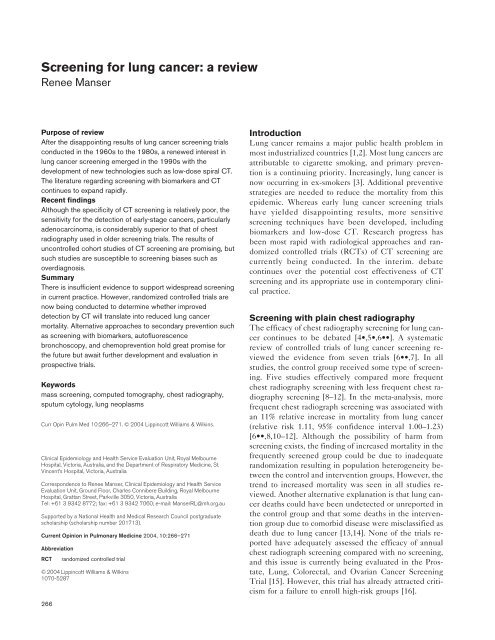
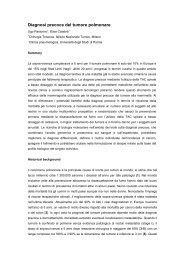

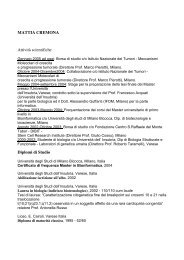



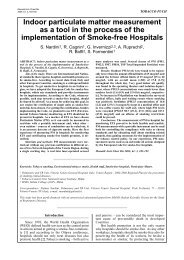
![STUDIO [18F]-FDG PET Total body](https://img.yumpu.com/18201937/1/190x135/studio-18f-fdg-pet-total-body.jpg?quality=85)
